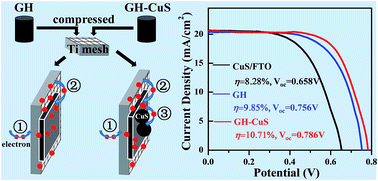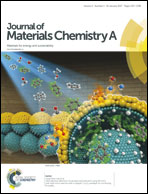Graphene hydrogel-based counter electrode for high efficiency quantum dot-sensitized solar cells†
Abstract
Although copper sulfide and/or carbon materials have been utilized in counter electrodes (CEs) due to their good catalytic activity and conductivity, the efficiency of the assembled quantum dot-sensitized solar cells (QDSCs) is still unsatisfactory because of the relatively low photovoltage (Voc), which is commonly less than 0.7 V. In this study, graphene hydrogels (GHs) compressed onto titanium mesh served as the CE and the assembled CdSeTe QDSCs exhibited a photovoltaic conversion efficiency (PCE) of 9.85% and a Voc as high as 0.756 V, which increased by 19.0% and 14.9%, respectively, and are higher than those of the conventional CuS on FTO. By incorporating CuS nanoparticles into GH during gelation, the as-prepared GH–CuS CEs show further improved performance and the maximum PCE and Voc obtained were 10.71% and 0.786 V, respectively. The fill factor of the cells was also continuously increased. The excellent performance of the devices could be attributed to the synergistic effects of the water-rich GH (having a 3D porous structure accompanied by good conductivity) and highly catalytic CuS, reflected from the small series resistance, high catalytic activity, small electron transfer resistance, and stability, which have been confirmed by EIS, Tafel polarization, and CV curves.

- This article is part of the themed collections: 2017 Journal of Materials Chemistry A HOT Papers and 2016 Journal of Materials Chemistry A HOT Papers

 Please wait while we load your content...
Please wait while we load your content...